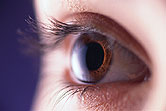- Skip Storing This Everyday Product in the Fridge Door
- Green Tea + B3 Pairing May Boost Brain Health
- Navigating Your Midlife Crisis: Embracing New Possibilities
- City Raccoons Showing Signs of Domestication
- Mapping the Exposome: Science Broadens Focus to Environmental Disease Triggers
- One Week Less on Social Media Linked to Better Mental Health
- Your Brain Changes in Stages as You Age, Study Finds
- Some Suicide Victims Show No Typical Warning Signs, Study Finds
- ByHeart Formula Faces Lawsuits After Babies Sickened With Botulism
- Switch to Vegan Diet Could Cut Your Greenhouse Gas Emissions in Half
Cosmetic Eye Procedure May Ease Migraines, Small Study Says


Cosmetic eyelid surgery involving specific nerves may do more than improve your looks — the procedure may also provide migraine relief for some, according to new research.
The technique involves making incisions in the upper eyelid to deactivate so-called “trigger” nerves. This process also lifts the lid, a technique known as blepharoplasty.
The new approach is an alternative to another surgery sometimes used to treat migraines. That one approaches the nerves under the skin but starts at the scalp.
Both procedures are known as trigger-site deactivation surgeries. Some neurologists and others who care for people with migraines view the procedures as unproven.
But when the surgery is used in appropriate patients, migraine improvement is common, said study researcher Dr. Oren Tessler, an assistant professor of clinical surgery at the Louisiana State University Health Sciences Center New Orleans School of Medicine.
“Ninety percent of our patients had over 50 percent improvement in their migraines,” he said. “After a year’s time, 51 percent had no migraines.”
“As a bonus they got an upper eyelid surgery,” added Tessler, who is also director of plastic surgery at University Hospital, New Orleans.
Not everyone agrees that this surgery is helpful, or even that freeing trapped nerves gets to the root of what causes migraines.
“I think it’s conceivable at least in principle that a nerve could be trapped,” said Dr. Vincent Martin, co-director of the headache and facial pain program at the University of Cincinnati School of Medicine in Ohio.
Martin said that while entrapped nerves may worsen migraines, he’s not convinced that they’re a cause of migraines.
In addition, “There are weaknesses in the way the study was designed,” he said, citing the lack of a control group. All 35 patients had the surgery so they couldn’t be compared against a “sham” surgery group, a common method in scientific studies.
“There’s a huge ‘placebo effect’ from surgical procedures,” Martin explained. In other words, they may think they feel better simply because they received treatment.
The study, published online recently in Plastic and Reconstructive Surgery, included 30 women and five men. Their average age was 46.
Tessler said patients have to be selected carefully because the surgery is meant for those whose migraines are caused by a compression of nerves as they exit the skull.
“You release the nerve and you remove the irritation,” Tessler said.
In his study, the average number of headache days reported by patients declined from 18.5 a month on average to fewer than four a month one year after the surgery.
“There have been no major complications,” he said. “Every patient will have some numbness because the nerve is in shock.” That numbness usually resolves, but a small amount may remain, he said. His patients tell him it’s a small price to pay for migraine relief.
The fees for the surgery, done as a cosmetic procedure, vary by doctor and region of the country. According to the American Society of Plastic and Reconstructive Surgeons, the average physician fee is about $3,000. The fee does not include any charges for the facility and anesthesia.
Tessler said the surgery, sometimes covered by insurance, takes about three hours. An incision is made in the upper eyelid to get to the specific nerves and release them. “It [also] takes away the bulge of the eyelid,” he said, giving a more youthful look.
Acknowledging the small study size, Tessler said more research is needed. None of the researchers disclosed financial interests in any of the products, devices or drugs discussed in the study.
Martin also believes more study is needed. This technique is “theoretically plausible, but not proven,” he said. “Most neurologists and headache doctors don’t think the evidence is sufficient to recommend this surgery at this time.”
More information
For more information on migraines, visit the U.S. National Institutes of Health.
Source: HealthDay
Copyright © 2025 HealthDay. All rights reserved.










